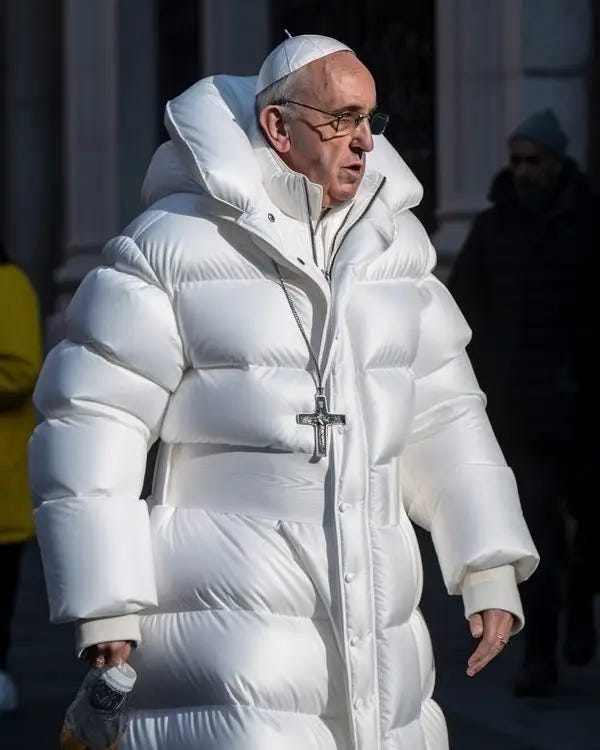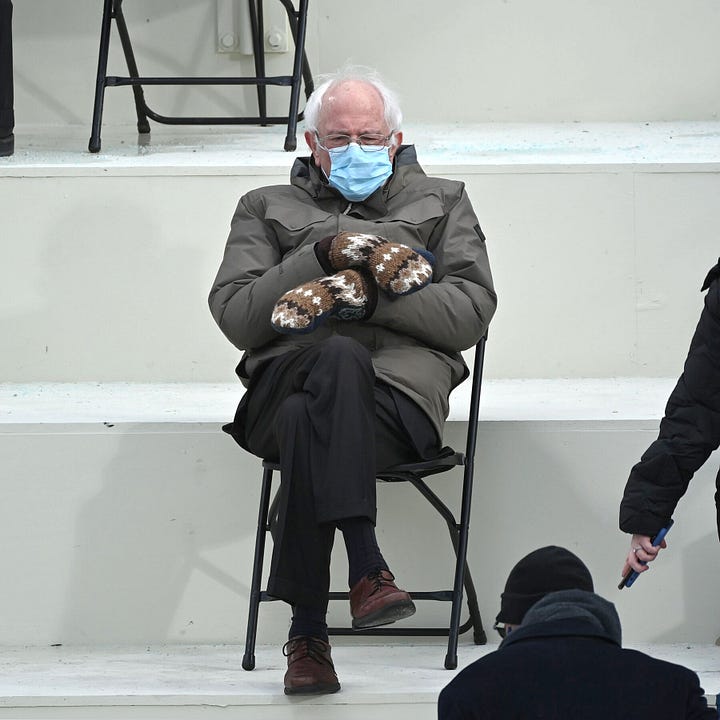A few weeks ago images of the Pope showed up on feeds, making me think that pontificate styling had either been taken over by Rick Owens or that Francis just really likes thicc jackets (I get it, I own like 100 puffer jackets myself). Turns out these images were generated by AI, and have since inspired many other metamodernist mockups. But that (gen-AI outfits) is for another day.
The puffer pope moment reminded me of this other famous meme featuring a prominent elder: Bernie Sanders sitting on the sidelines in mittens that inspired a wave of similar pairs by brands with tuned-in marketing departments shortly after.


When you read today’s headline this is probably what you had in mind. Brands taking advantage of a cultural moment and quickly incorporating it in their creative practice. You may also remember the Simpsons on Balenciaga, or Loewes NFT-inspired pixel pieces. While it isn’t a new phenomenon for creatives to reference popular culture in their work, what I really want to draw your attention to is something else. Something other than brands repurposing existing memes and securing relevance by association.
Whoever picked up Bernie’s image and made it go viral successfully created a story that others felt compelled to indulge in and share, triggering community-lead memefication of an otherwise dull fashion moment. The products that followed, and the people who bought them, became symbols of this moment, representing a virtual conversation, and signalling their participation in it.
In today's world, fashion is more than just a way to dress or look good. While Bernie’s gloves are probably the least sexy of examples, they show how powerful of a communication tool fashion has become, especially in communicating personal levels of cultural savvy. A skill that has become ever more relevant since the internet, and specifically social media, have introduced a treasure trove of cultural moments, a giant library of eras, designers and tastes ready to be rabbit holed, featured and globalized. In a time where information is abundant and readily available through little computers in our micro bags, and where we get showered with visual material that we’re expected to sift through for entertainment1, fashion isn’t only a medium for personal expression. It’s the OG meme: a visual shorthand that communicates cultural cues and identifies communities on an internet scale.
Today’s fashion memes are community-made, fragmented and subtle to the untrained eye. Being culturally fluent can mean recognizing a TikTok trend or the Matilda Djerf effect, if not sporting a YSL Mombasa to signal that you, too, are aware of all of Tom Ford’s CD appointments. Understanding these cultural cues, i.e. IYKYK, therefore is the true quiet luxury. People who can recognize and understand the memes can successfully manoeuvre a globalized taste landscape, dodge culturally-oversaturated bullets and distinguish themselves from the masses by originality. The epitome of luxury thus isn’t wearing the Gucci Gazelles but rather finding a pair that is niche, rare or completely off the beaten track.
This newfound cultural awareness, i.e. fashion as memes, is also what has sparked a boon in the second-hand market. As people seek to buy into a community and a way of life, items with cultural significance are in high demand, even at a premium. For consumers, community belonging and a way to signal cultural savvy translate into heightened emotional connection to the item, a positive side effect, I find, which may curb mindless and over-consumption. For brands, understanding the power of cultural cues is not just a luxury but a necessity. In this digital life where memes reign supreme, brands that can align themselves with the aesthetic code of a community will find themselves basking in the warm glow of relevance. It's about embracing the nuances, understanding what makes a specific cultural movement tick, and incorporating those elements into the fabric of your brand's identity. In this game, too, knowing the memes, not reproducing them, is the real secret sauce.
Now, friends, I invite you to take a moment to think about what meme you’re wearing today. Because no matter if you’re aware of it or not, your clothes are telling a story. And who knows, you might walk out the door and bump into a stranger who understands the story, who recognizes your aesthetic code, who speaks your language. And maybe, maaaaybe, they’ll drop a comment like ‘ahh someone I can connect with’ (this literally happened to me a few days ago).
Because in a consumption-driven, lonely world, where we’ve formed stronger connections with strangers on a screen than with our own bodies, let alone other people in our lives, we need something that binds us together. So let’s open ourselves up to a world of meme-lead communities and embrace fashion’s capacity to keep us connected.
(Think about that. Who wants to spend their time checking images and videos for something they find interesting. I mean..seriously? It sounds even less exciting when many of the images are produced by professionals, made to make us feel a certain way and deemed successful when many of us have seen, forwarded or left a mark on them (i.e. liking and commenting). Yet, we still do it. For the simple pleasure of stumbling across a picture of pope Francis in a voluptuous coat that looks like Rick Owens ca 2012. )





this is it!
- all I ever wanted to read about memes and quiet luxury 🪩